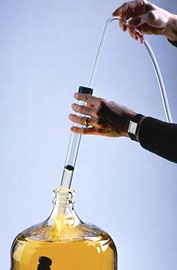 I used too much Speedy Bentonite to clear my last batch of wine. The bentonite worked, but there is a bunch of sediment. I racked off the wine that was clear. It tasted fine. There is about a gallon and a half of sediment. Will the bentonite continue to settle and is it worth the time and trouble for a few extra bottles
I used too much Speedy Bentonite to clear my last batch of wine. The bentonite worked, but there is a bunch of sediment. I racked off the wine that was clear. It tasted fine. There is about a gallon and a half of sediment. Will the bentonite continue to settle and is it worth the time and trouble for a few extra bottles
Name: Hans Wikle
State: WV
Hello Hans,
The general rule-of-thumb is to always get as much liquid as you can when you rack (siphon) your wine, even if it comes along with some sediment. It is only during your last racking, before bottling, that you need to be concerned with leaving all the sediment behind. By the time you get to that part of the process there will be little more than a dusting of sediment to avoid.
If you use this approach what you will discover is that your homemade wine will be just as clear when it comes time to bottle, and you will have much less loss of wine. This is true whether or not you add Bentonite to the wine.
You said you have already racked the wine, so I am assuming that you have a fermenter with this sediment and liquid in the bottom. Go ahead and try to get the liquid out and add it to your new fermenter that you just racked into. In the future, when your rack your wine, don’t stop when you get to the sediment, just keep going until you have all the liquid.
One item you may want to consider purchasing is a racking cane. It is basically a piece of clear rigid tubing that you slip onto the end of your siphon hose. Not only will it help you to direct where your siphon is pulling from (like a wand), it also comes with a diversion cap on the very tip of the wand. This keeps your from accidentally digging the racking cane into the packed sediment and drawing it. These racking canes come on all different lengths and have a curve at the top-end so that you do not have to worry about your siphon hose crimping as it comes out of the fermenter.
Best Wishes,
Ed Kraus
———————————————————————————————————
Ed Kraus is a 3rd generation home brewer/winemaker and has been an owner of E. C. Kraus since 1999. He has been helping individuals make better wine and beer for over 25 years.

I have a hydrometer ,and still don’t know how to use it.
I have a keg system and was wondering if I could keg a batch of wine. What CO2 pressure would keep the wine from becoming carbonated, yet still flow from the keg to the tap?
Hi I made some grape wine and I made some pear wine . my wine is cloudy. The grape is not as cloudy as the pear. I used a clearing agent that I purchaced from you. The wine did’nt clear up.what should I do?
I cleared my wine by adding egg white to it. It was very cloudy because of the wheat and yeast. Now it has become crystal clear. Try egg white. It really works to clear up a cloudy and foggy wine!
Ed, if you still have the directions that came with the hydrometer I would start there. You can even take some wine — commercial or homemade — an practice using the hydrometer on them. There is also a great article on our website that gives a good introduction to using the hydrometer: "Getting To Know Your Hydrometer".
http://www.eckraus.com/wine-making-hydrometer/
Robert, it is going to be different in each situation. The biggest factor being the length of your hose. Having said that, you want the hose to be as short as possible. At a foot or two you can get away with 3 to 5 pounds of pressure. If you really want to do this correctly, then you should switch over to nitrogen from the CO2. Nitrogen has a much harder time bonding with the wine.
Bruce, there are several reasons why this could be. Here’s a blog post that goes over some of them: "4 Reasons Why Your Wine Might Not Be Clearing…" http://blog.eckraus.com/wine-making-stories/wine-not-clearing
I hate to leave anything behind! I use a siphoning cane to start, maintain a steady hand – do not move, or it will stir up sediment. Hold the cane steady @ 90 degs until syphon stops. Have someone else handle the other end. If there’s wine remaining, I put it in a 1.5L bottle with a Zylis clamp cork and turn it upside down in the fridge for a day or two. the cold helps the settling. Open the clamp over a sink and allow the sediment to escape, save the remaining wine. i mostly use it for topping up another batch or cooking.
Hi Ed. I think your blog is fantastic. This is the first time l have made wine with the grapes from my garden (in London!). Every question l’ve had, your blog has answered. So far l have 4.5 litres of not-bad-for-a-first-effort red table wine which l am about to bottle. I am looking forward to drinking it next September. Thank you for all the advice! Victoria
We are making applejack and I don’t want to throw out the sediment and pulp in the bottom of the jar so I was researching what you said about making second wine out of it. I don’t have an andrometer thing so I think I’ll go pick one up tomorrow. Thanks for all of your fabulous suggestions.